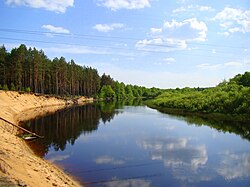Berezina
| Berezina | |
|---|---|
 Berezina River in Belarus | |
 | |
| Native name | Бярэзіна (Belarusian) |
| Location | |
| Country | Belarus |
| Physical characteristics | |
| Source | |
| • location | Belarus |
| Mouth | Dnieper |
• coordinates | 52°32′59″N 30°15′00″E / 52.54972°N 30.25000°E |
| Length | 561 km (349 mi)[1] |
| Basin size | 24,500 km2 (9,500 sq mi)[1] |
| Basin features | |
| Progression | Dnieper→ Dnieper–Bug estuary→ Black Sea |
 | |
The Berezina or Byarezina[2] (Belarusian: Бярэзіна, romanized: Biarezina,[3] IPA: [bʲaˈrɛzʲinɐ]; Russian: Березина) is a river in Belarus and a right tributary of the Dnieper. The river starts in the Berezinsky Biosphere Reserve. The length of the Berezina is 613 kilometres (381 mi). The width of the river is 15–20 m, the maximum is 60 m. The banks are low (up to 0.5 m), steep in some areas (up to 1.5 m high), sandy, and the floodplain is swampy. The Berezina usually freezes over in the first half of December.
Its main tributaries are Bobr, Klyava, Ol'sa and Ala from the left and Hayna and Svislach from the right.[4] The Berezinsky Biosphere Reserve by the river is on the UNESCO list of biosphere reserves. Peat bogs cover 430 km2 and thus occupy a large part of the reserve. These open peat zones have remained virtually untouched and are among Europe's largest bogs.
Settlements
Cities and towns on the Berezina from north to south include:
Historical significance
- Charles XII of Sweden's army crossed the Berezina on 25 June 1708, during his campaign against Peter the Great of Russia in the Great Northern War. (see ISBN 0-306-80863-3 for details)
- Napoleon Bonaparte's army suffered heavy losses (about 50,000) when they were crossing the Berezina in November 1812, during the retreat from Russia (see Battle of Berezina). Since then "Berezina" is used in French as a synonym for catastrophe. See Charles Joseph Minard § The map of Napoleon's Russian campaign for a visual graphic of the army's fate
- Several armies in German Wehrmacht Army Group Centre were entrapped and prevented from crossing the Berezina in June 1944, during the envelopment phases of the Bobruysk and Minsk Offensives, within the closing phases of Operation Bagration in World War II.
- There were military actions between Germany and Russia at the Berezina River in 1917–1918.[citation needed]
- Several battles are named after the river.
References
- ^ a b "Main Geographic Characteristics of the Republic of Belarus. Main characteristics of the largest rivers of Belarus". Land of Ancestors. Data of the Ministry of Natural Resources and Environmental Protection of the Republic of Belarus. 2011. Archived from the original on 15 January 2014. Retrieved 27 September 2013.
- ^ "Byarezina River". britannica.com.
- ^ official transliteration
- ^ Березина, Great Soviet Encyclopedia

